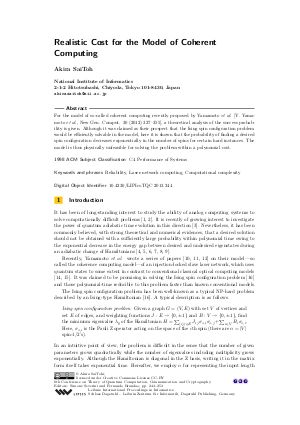Realistic Cost for the Model of Coherent Computing
Author Akira SaiToh
-
Part of:
Volume:
8th Conference on the Theory of Quantum Computation, Communication and Cryptography (TQC 2013)
Part of: Series: Leibniz International Proceedings in Informatics (LIPIcs)
Part of: Conference: Conference on the Theory of Quantum Computation, Communication and Cryptography (TQC) - License:
 Creative Commons Attribution 3.0 Unported license
Creative Commons Attribution 3.0 Unported license
- Publication Date: 2013-11-13
File

PDF
LIPIcs.TQC.2013.244.pdf
- Filesize: 467 kB
- 10 pages
Document Identifiers
Subject Classification
Keywords
- Reliability
- Laser-network computing
- Computational complexity
Metrics
- Access Statistics
-
Total Accesses (updated on a weekly basis)
0PDF Downloads0Metadata Views
Abstract
For the model of so-called coherent computing recently proposed by Yamamoto et al. [Y. Yamamoto et al., New Gen. Comput. 30 (2012) 327-355], a theoretical analysis of the success probability is given. Although it was claimed as their prospect that the Ising spin configuration problem would be efficiently solvable in the model, here it is shown that the probability of finding a desired spin configuration decreases exponentially in the number of spins for certain hard instances. The model is thus physically unfeasible for solving the problem within a polynomial cost.
Cite As Get BibTex
Akira SaiToh. Realistic Cost for the Model of Coherent Computing. In 8th Conference on the Theory of Quantum Computation, Communication and Cryptography (TQC 2013). Leibniz International Proceedings in Informatics (LIPIcs), Volume 22, pp. 244-253, Schloss Dagstuhl – Leibniz-Zentrum für Informatik (2013)
https://doi.org/10.4230/LIPIcs.TQC.2013.244
BibTex
@InProceedings{saitoh:LIPIcs.TQC.2013.244,
author = {SaiToh, Akira},
title = {{Realistic Cost for the Model of Coherent Computing}},
booktitle = {8th Conference on the Theory of Quantum Computation, Communication and Cryptography (TQC 2013)},
pages = {244--253},
series = {Leibniz International Proceedings in Informatics (LIPIcs)},
ISBN = {978-3-939897-55-2},
ISSN = {1868-8969},
year = {2013},
volume = {22},
editor = {Severini, Simone and Brandao, Fernando},
publisher = {Schloss Dagstuhl -- Leibniz-Zentrum f{\"u}r Informatik},
address = {Dagstuhl, Germany},
URL = {https://drops.dagstuhl.de/entities/document/10.4230/LIPIcs.TQC.2013.244},
URN = {urn:nbn:de:0030-drops-43249},
doi = {10.4230/LIPIcs.TQC.2013.244},
annote = {Keywords: Reliability, Laser-network computing, Computational complexity}
}
